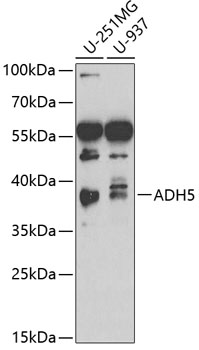Anti-ADH5 Antibody (CAB2041)
- SKU:
- CAB2041
- Product type:
- Antibody
- Reactivity:
- Human
- Reactivity:
- Mouse
- Host Species:
- Rabbit
- Isotype:
- IgG
- Research Area:
- Cell Biology
Description
| 抗体名: | Anti-ADH5 Antibody |
| 抗体コード: | CAB2041 |
| 抗体サイズ: | 20uL, 50uL, 100uL |
| 申し込み: | WB |
| 反応性: | Human, Mouse |
| 宿主種: | Rabbit |
| 免疫原: | Recombinant fusion protein containing a sequence corresponding to amino acids 1-374 of human ADH5 (NP_000662.3). |
| 申し込み: | WB |
| 推奨希釈: | WB 1:500 - 1:2000 |
| 反応性: | Human, Mouse |
| ポジティブサンプル: | U-251MG, U-937 |
| 免疫原: | Recombinant fusion protein containing a sequence corresponding to amino acids 1-374 of human ADH5 (NP_000662.3). |
| 精製方法: | Affinity purification |
| ストレージバッファ: | Store at -20'C. Avoid freeze / thaw cycles. Buffer: PBS with 0.02% sodium azide, 50% glycerol, pH7.3. |
| アイソタイプ: | IgG |
| 順序: | MANE VIKC KAAV AWEA GKPL SIEE IEVA PPKA HEVR IKII ATAV CHTD AYTL SGAD PEGC FPVI LGHE GAGI VESV GEGV TKLK AGDT VIPL YIPQ CGEC KFCL NPKT NLCQ KIRV TQGK GLMP DGTS RFTC KGKT ILHY MGTS TFSE YTVV ADIS VAKI DPLA PLDK VCLL GCGI STGY GAAV NTAK LEPG SVCA VFGL GGVG LAVI MGCK VAGA SRII GVDI NKDK FARA KEFG ATEC INPQ DFSK PIQE VLIE MTDG GVDY SFEC IGNV KVMR AALE ACHK GWGV SVVV GVAA SGEE IATR PFQL VTGR TWKG TAFG GWKS VESV PKLV SEYM SKKI KVDE FVTH NLSF DEIN KAFE LMHS GKSI RTVV KI |
| 遺伝子ID: | 128 |
| Uniprot: | P11766 |
| セルラーロケーション: | Cytoplasm |
| 計算された分子量: | 39kDa |
| 観察された分子量: | 38kDa |
| 同義語: | ADH5, ADH-3, ADHX, FALDH, FDH, GSH-FDH, GSNOR, HEL-S-60p |
| バックグラウンド: | This gene encodes a member of the alcohol dehydrogenase family. Members of this family metabolize a wide variety of substrates, including ethanol, retinol, other aliphatic alcohols, hydroxysteroids, and lipid peroxidation products. The encoded protein forms a homodimer. It has virtually no activity for ethanol oxidation, but exhibits high activity for oxidation of long-chain primary alcohols and for oxidation of S-hydroxymethyl-glutathione, a spontaneous adduct between formaldehyde and glutathione. This enzyme is an important component of cellular metabolism for the elimination of formaldehyde, a potent irritant and sensitizing agent that causes lacrymation, rhinitis, pharyngitis, and contact dermatitis. The human genome contains several non-transcribed pseudogenes related to this gene. |
| UniProt Protein Function: | ADH5: Class-III ADH is remarkably ineffective in oxidizing ethanol, but it readily catalyzes the oxidation of long-chain primary alcohols and the oxidation of S-(hydroxymethyl) glutathione. Belongs to the zinc-containing alcohol dehydrogenase family. Class-III subfamily. |
| UniProt Protein Details: | Protein type:Energy Metabolism - methane; Oxidoreductase; Xenobiotic Metabolism - metabolism by cytochrome P450; EC 1.1.1.1; Lipid Metabolism - fatty acid; Mitochondrial; Carbohydrate Metabolism - glycolysis and gluconeogenesis; Xenobiotic Metabolism - drug metabolism - cytochrome P450; Amino Acid Metabolism - tyrosine; Cofactor and Vitamin Metabolism - retinol; EC 1.1.1.284 Chromosomal Location of Human Ortholog: 4q23 Cellular Component: mitochondrion; nucleus Molecular Function:protein homodimerization activity; electron carrier activity; zinc ion binding; formaldehyde dehydrogenase activity; alcohol dehydrogenase activity; S-(hydroxymethyl)glutathione dehydrogenase activity; fatty acid binding Biological Process: response to nitrosative stress; respiratory system process; ethanol catabolic process; formaldehyde catabolic process; peptidyl-cysteine S-nitrosylation; response to redox state; response to lipopolysaccharide; retinoid metabolic process; ethanol oxidation; positive regulation of blood pressure; aging |
| NCBI Summary: | This gene encodes a member of the alcohol dehydrogenase family. Members of this family metabolize a wide variety of substrates, including ethanol, retinol, other aliphatic alcohols, hydroxysteroids, and lipid peroxidation products. The encoded protein forms a homodimer. It has virtually no activity for ethanol oxidation, but exhibits high activity for oxidation of long-chain primary alcohols and for oxidation of S-hydroxymethyl-glutathione, a spontaneous adduct between formaldehyde and glutathione. This enzyme is an important component of cellular metabolism for the elimination of formaldehyde, a potent irritant and sensitizing agent that causes lacrymation, rhinitis, pharyngitis, and contact dermatitis. The human genome contains several non-transcribed pseudogenes related to this gene. [provided by RefSeq, Oct 2008] |
| UniProt Code: | P11766 |
| NCBI GenInfo Identifier: | 113408 |
| NCBI Gene ID: | 128 |
| NCBI Accession: | P11766.4 |
| UniProt Related Accession: | P11766 |
| Molecular Weight: | |
| NCBI Full Name: | Alcohol dehydrogenase class-3 |
| NCBI Synonym Full Names: | alcohol dehydrogenase 5 (class III), chi polypeptide |
| NCBI Official Symbol: | ADH5 |
| NCBI Official Synonym Symbols: | FDH; ADHX; ADH-3; FALDH; GSNOR; GSH-FDH; HEL-S-60p |
| NCBI Protein Information: | alcohol dehydrogenase class-3 |
| UniProt Protein Name: | Alcohol dehydrogenase class-3 |
| UniProt Synonym Protein Names: | Alcohol dehydrogenase 5; Alcohol dehydrogenase class chi chain; Alcohol dehydrogenase class-III; Glutathione-dependent formaldehyde dehydrogenase (EC:1.1.1.-); FALDH; FDH; GSH-FDH; S-(hydroxymethyl)glutathione dehydrogenase (EC:1.1.1.284) |
| UniProt Gene Name: | ADH5 |
| UniProt Entry Name: | ADHX_HUMAN |


